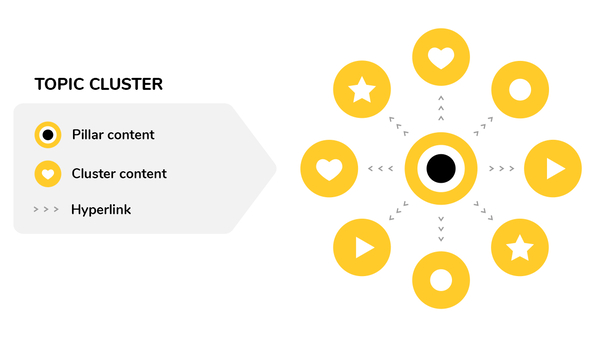Zapis je na voljo tudi v slovenščini
When we’re in the process of buying something, each of us goes on a so-called buyer's journey. First we have to find out what we really want. How would we define the problem or challenge we are facing? Once we find this out, we start looking for possible solutions, something that would help us to solve the problem successfully. Finally, from the set of possible solutions (be it products or services), we choose the one we think is most suitable for us.
Our prospects follow the same path, and it is our job to catch them with good content in one of these stages and convince them to choose our product or service.
| The buyer’s journey is the process that buyers go through when they become aware of, consider, evaluate, and decide to purchase a new product or service. |
Inbound marketing is about finding ways to attract our ideal customers (or personas) to our website with the highest quality content and then turning as many of these visitors as possible into customers, and then on to our promoters. The buyer’s journey is one of the five pillars of inbound marketing.
There are three steps on this path, which speak about where our persona is at the moment when he or she encounters our content. Maybe she wants to learn something new, maybe she already knows the basics and needs additional, more in-depth information, or maybe she is about to make a purchase and just has to decide who she trusts more - us or one of our competitors.
Awareness – our customer realizes they have a problem
The first step is called the awareness stage: This is the period in which our prospect or persona recognizes that they have a problem or are faced with a particular challenge. The prospect does not yet understand exactly how to frame or name the problem, so he or she does educational research.
At this stage, we need to provide our persona with educational content, such as educational blog posts, well-designed and informative infographics, educational video content, podcasts, e-books, relevant research reports or similar.
When it comes to content topics, we need to know what our existing customers were looking for when they came across our product or service. The employees who are most in contact with our customers can help us find the most relevant topics.
We should ask ourselves the following questions:
- How do our customers describe their goals or challenges?
- How do customers find out how they can achieve these goals or solve these challenges?
- What are the consequences of inaction by the customer?
- Are there common misunderstandings that customers have about addressing the goal or challenge?
- How do customers decide whether to give priority to the goal or challenge?
Consideration – our customer defines their problem and starts looking for solutions
The second step is called consideration stage: our personas are well aware of their true goal or challenge. They have decided to take up the challenge and solve it, so they start looking for possible solutions. Will our product or service help them achieve their goal?
When we’re thinking about content topic for the consideration stage, we should ask ourselves the following questions:
- What solutions are the customers investigating?
- How do customers find out about the different solutions?
- How do customers distinguish between the pros and cons of each solution?
- How do customers decide which solution is right for them?
At this stage, we can offer them various technical content related to our product or service, the possibility of live interactions (we can share our calendar with them so they can choose when they want to discuss a particular topic, or set up a chatbot or live chat with someone from our team), in-depth blog posts, webinars, podcasts, video content, product or service comparisons and much more. The content already deals in more detail with topics related to our products or services.
Decision – our customer chooses a solution
The last step is related to the purchase decision: In the decision stage, customers already know exactly what they need to do to solve a problem or achieve a goal. They only have to decide whether to go for our solution or the solution of our competition. It is therefore crucial that we provide them with as much information as possible to convince them that our solution is the right one for them.
Questions that help us to find the right content topics for customers who are in the decision stage:
- What criteria do customers use to evaluate the available solutions (products or services)?
- What could convince customers to choose our solution instead of our competitions? What concerns could they have with our solution?
- Is there someone else on the customer’s side who is involved in the decision? How does their perspective on the decision differ?
- Do customers expect to try our product or service before they purchase it?
- Outside of purchasing, Do customers need to make additional preparations outside of purchasing in order to use our solution, such as special training or similar?
The content we can offer at this stage: comparisons between vendors, comparisons between specific products or services, case studies, research, we can offer them the opportunity to test our product or a live demo, and high quality content about our products or services. At this stage, we need to offer those who are considering buying from us the opportunity to learn as much as possible about who we are and what product or service they are purchasing.
Defining individual topics that are relevant to our persona
We need to divide content from each stage of the buyer’s journey (awareness, consideration, decision) into key areas that are relevant to our personas.
Then we should create a separate content plan for each persona and divide the content into individual topics. For example, for each theme – each stage of the buyer’s journey – we can plan 5 pieces of content. The main topic is presented on the more extensive pillar page, which is connected to the 15 content pieces that we plan to include. In this way we get a so-called topic cluster, which is one of the latest ways for optimizing your website for search engines (SEO).

What content should we offer at different stages of the buyer’s journey?
| Pillar No. 1 | ||
| Awareness | Consideration | Decision |
|
|
|
Do you need help with creating buyer's journey?Contact us and let's talk about how can we help you. |



